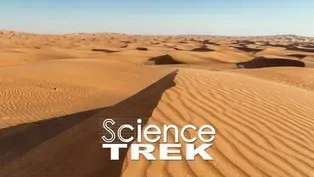
Deserts: Cold Deserts
Clip: Special | 1m 4sVideo has Closed Captions
What is the difference between a cold and a polar desert?
Cold deserts are exactly that, cold! They happen along mountain tops, high plateaus, and in the polar regions. Antarctica is the planet’s largest cold desert.
Problems with Closed Captions? Closed Captioning Feedback
Problems with Closed Captions? Closed Captioning Feedback
Science Trek is a local public television program presented by IdahoPTV
Major Funding by the Laura Moore Cunningham Foundation and the Idaho National Laboratory. Additional Funding by the Friends of Idaho Public Television and the Corporation for Public Broadcasting.

Deserts: Cold Deserts
Clip: Special | 1m 4sVideo has Closed Captions
Cold deserts are exactly that, cold! They happen along mountain tops, high plateaus, and in the polar regions. Antarctica is the planet’s largest cold desert.
Problems with Closed Captions? Closed Captioning Feedback
How to Watch Science Trek
Science Trek is available to stream on pbs.org and the free PBS App, available on iPhone, Apple TV, Android TV, Android smartphones, Amazon Fire TV, Amazon Fire Tablet, Roku, Samsung Smart TV, and Vizio.

Science Trek
Science Trek is a place where parents, kids, and educators can watch short, educational videos on a variety of science topics. Every Monday Science Trek releases a new video that introduces children to math, science, technology, engineering, and math (STEM) career potentials in a fun, informative way.[MUSIC] JOAN CARTAN-HANSEN, HOST: There're basically four types of deserts: Hot and dry, cold, semiarid, and coastal.
This time, we're talking about cold deserts.
Cold deserts are what you'd expect, areas with little precipitation and very cold temperatures.
Most cold deserts are found in high elevations, on plateaus or mountain ranges.
Plants and animals have specialized adaptations to live in these freezing areas.
Artic hares have thick white coats to stay warm and to blend in with the snow to avoid predators.
The largest cold desert is Antarctica.
Cold deserts there and in the Arctic are also called polar deserts.
Polar deserts have extremely low temperatures and they're mostly icy landscapes.
Few plants and animals live in polar deserts.
The most famous is the polar bear.
But cold deserts and polar bears are endangered because of warming temperatures and climate change.
For more information about deserts, check out the science trek website.
You'll find it at science trek dot org
Video has Closed Captions
Clip: Special | 1m 4s | What is a dromedary? (1m 4s)
Providing Support for PBS.org
Learn Moreabout PBS online sponsorshipSupport for PBS provided by:
Science Trek is a local public television program presented by IdahoPTV
Major Funding by the Laura Moore Cunningham Foundation and the Idaho National Laboratory. Additional Funding by the Friends of Idaho Public Television and the Corporation for Public Broadcasting.












